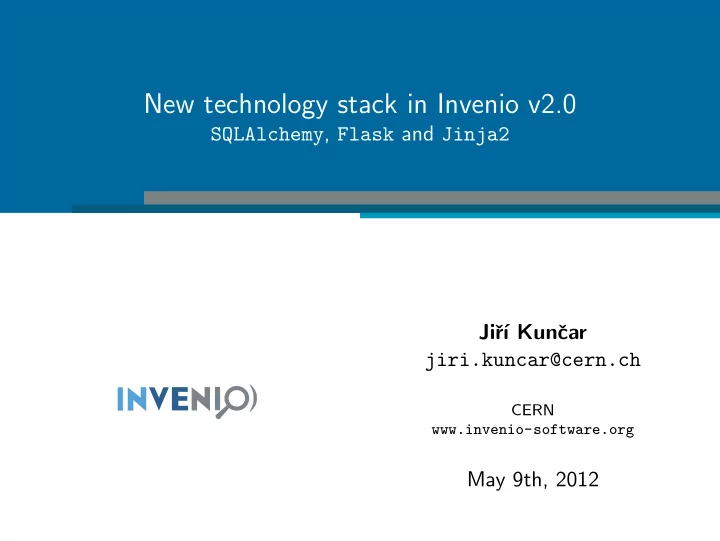

New technology stack in Invenio v2.0 SQLAlchemy , Flask and Jinja2 Jiˇ r´ ı Kunˇ car jiri.kuncar@cern.ch CERN www.invenio-software.org May 9th, 2012
Outline Introduction Model Controller View Invenio Integration Models Testing Performance Migration Decorators Conclusion 2 of 23
3 of 23
Database layer SQLAlchemy • Library providing a Python-ic interface to relational databases • Includes powerful SQL expression language • ”Simple things simple, and complex things possible.” 4 of 23
Database layer SQLAlchemy • Library providing a Python-ic interface to relational databases • Includes powerful SQL expression language • ”Simple things simple, and complex things possible.” How is it going to be useful in Invenio? ? • Database independence • Easier query building • Advanced features: Horizontal Sharding, Versioned Objects 4 of 23
Database Independence run_sql() 5 of 23
Database Independence run_sql() 5 of 23
Object Relation Mapping (ORM) Why SQLAlchemy? Collection id +sons • Support for wide variety of database and architectural designs by flexible model definitions • Mature, High Performing Architecture • Composite PK and FK represented as sets of columns • Simple definition of relations • db.metadata.create all() Database 6 of 23
7 of 23
Flask Description • Lightweight • Build on top of Werkzeug • Wide range of extensions: assets, cache, testing, sqlalchemy • Blueprints : pluggable architecture • Powerful URL routing system: multiple rules per function, remapping 8 of 23
Jinja2 Description • Unicode support • Template inheritance • Sandboxed execution mode, (auto)escaping • Loop controls: index, first, last, odd • Template designer helpers: batch, split, filter • { % css ’css/invenio.css’ % } • { % js ’css/jquery.js’ % } 9 of 23
Outline Introduction Model Controller View Invenio Integration Models Testing Performance Migration Decorators Conclusion 10 of 23
Invenio Model Features I Declarative model • Table name • Basic types ( Integer, String, DateTime, Binary ) • Database specific options ( Enum, Autoincrement ) • Definitions in db object class MsgMESSAGE(db.Model): __tablename__ = ’msgMESSAGE’ id = db.Column(db.Integer(15, unsigned=True), nullable=False, primary_key=True, autoincrement=True) subject = db.Column(db.Text, nullable=False) body = db.Column(db.Text, nullable=True) sent_date = db.Column(db.DateTime, nullable=False, server_default=’0001-01-01�00:00:00’) received_date = db.Column(db.DateTime, server_default=’0001-01-01�00:00:00’) 11 of 23
Invenio Model Features II Relations • Foreign key definition • Relation with back-reference • Simplified One-to-One, One-to-Many, and Many-to-Many relations ( AssociationProxy ) id_user_from = db.Column(db.Integer(15, unsigned=True), db.ForeignKey(User.id), nullable=True, server_default=’0’) user_from = db.relationship(User, backref=’sent_messages’) recipients = association_proxy(’sent_to_users’, ’user_to’, creator=lambda u:UserMsgMESSAGE(user_to=u)) 12 of 23
Invenio Model Features III Properties, Validations • Column aliases – @property , @db.hybrid property • Validators – @db.validates _sent_to_user_nicks = db.Column(db.Text, name=’sent_to_user_nicks’, nullable=False) @db.hybrid_property # @property def user_nicks(self): if not self._sent_to_user_nicks: return [] return filter(len, map(strip, self._sent_to_user_nicks.split(CFG_WEBMESSAGE_SEPARATOR))) @db.validates(’_sent_to_user_nicks’) def validate_sent_to_user_nicks(self, key, value): user_nicks = filter(len, map(strip, value.split(CFG_WEBMESSAGE_SEPARATOR))) assert len(user_nicks) == len(set(user_nicks)) assert len(user_nicks) == User.query.filter(User.nickname.in_(user_nicks)).count() return CFG_WEBMESSAGE_SEPARATOR.join(user_nicks) 13 of 23
Invenio Model Features IV @sent_to_user_nicks.setter def sent_to_user_nicks(self, value): old_user_nicks = self.user_nicks self._sent_to_user_nicks = value to_add = set(self.user_nicks)-set(old_user_nicks) to_del = set(old_user_nicks)-set(self.user_nicks) to_del = to_del-set([u.nickname for u in User.query.\ join(User.usergroups).filter( Usergroup.name.in_(self.group_names)).\ all()]) if len(to_del): is_to_del = lambda u: u.nickname in to_del remove_old = filter(is_to_del, self.recipients) for u in remove_old: self.recipients.remove(u) if len(to_add): for u in User.query.filter(User.nickname.\ in_(to_add)).all(): if u not in self.recipients: self.recipients.append(u) 14 of 23
Database Independence Testing • Using alternative databases alongside production database. • MySQL , PostgreSQL and SQLite • Fixtures : specific data for each test case, possible universal replacement for tablefill.sql . from invenio.websession_model import User fixture = FlaskSQLAlchemyFixture( class UserData(DataSet): env={’UserData’: User}, class admin: engine=db.metadata.bind, nickname = ’admin’ session=db.session email=nickname+"@example.com" ) class romeo(admin): nickname = ’romeo’ @fixture.with_data(UserData) class juliet(admin): def test_index(data, self): nickname = ’juliet’ # test code > sudo -u www-data /opt/invenio/bin/inveniocfg --run-flask-tests 15 of 23
Performance Common problems • Too many queries. • Gathering too much data. • ORM is sometimes simply too slow. There are solutions how to speed it up: http://invenio-software.org/wiki/Tools/SQLAlchemy/Performance 16 of 23
Migration Common use-cases • Schema upgrade (downgrade) • Data transfer between instances ( dev, prod ) • Data format: Fixtures python classes, ini text format • sqlalchemy-migrate , Alembic , or own solution 17 of 23
Filter and Sort Decorators Features • generate WHERE and ORDER BY statements • specify different compare functions: equal, startswith, like %. . . % • keep filter while sorting and vice versa Decorators @blueprint.invenio_sorted(MsgMESSAGE) @blueprint.invenio_filtered(MsgMESSAGE, columns={ ’subject’:operators.startswith_op, ’user_from.nickname’:operators.contains_op}, form=FilterMsgMESSAGEForm) def index(sort=None, filter=None): # ... 18 of 23
Web Messages http://localhost:8080/yourmessages/display?sort_by=sent_ date&order=desc&user_from.nickname=juli&subject=s 19 of 23
REST API Templated • Automatically calls render template() with appropriate template • Guess name of template if it is not defined • On XHR returns JSON Decorator @blueprint.route(’/index’) @blueprint.invenio_templated() def index(): return dict(users=User.query.all()) 20 of 23
Outline Introduction Model Controller View Invenio Integration Models Testing Performance Migration Decorators Conclusion 21 of 23
Summary • Created all models for tables in master branch. • Implemented WebMessage module as a proof of concept showing some of the advanced SQLAlchemy features. • Prepared for the future generalized database table creater and updater tool. • Tested DB independence with MySQL, SQLite, PostgreSQL for WebMessage module. • Enriched Flask framework with SQLAlchemy friendly decorators for sorting and filtering. 22 of 23
Share your ideas http://invenio-software.org/wiki/Talk ? 23 of 23
Share your ideas http://invenio-software.org/wiki/Talk 23 of 23
Recommend
More recommend